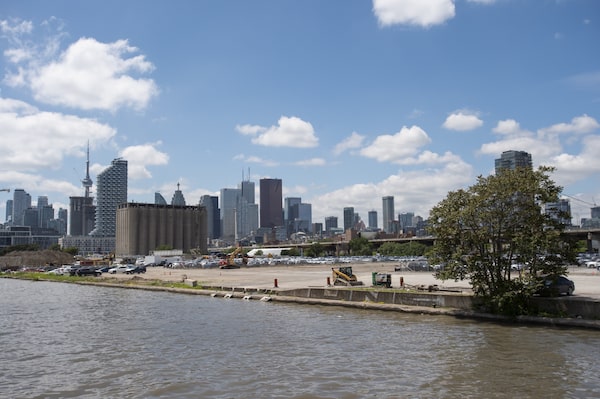
The board of Waterfront Toronto, an agency of all three levels of government that is charged with reimagining the city’s slice of Lake Ontario shoreline, is expected to vote Thursday morning on the plan.Andrew Lahodynskyj/The Canadian Press
Sidewalk Labs and Waterfront Toronto are getting closer to an agreement to go ahead with a high-tech community on valuable lakefront property at a much smaller scale than the Google sister company asked for in June.
The discussions are focused on a development that is similar in size to the one Waterfront Toronto first envisioned, set on a 12-acre site at the foot of Parliament Street, according to four sources familiar with the situation. The sources were granted confidentiality because they were not authorized to speak publicly about the negotiations.
Two of the sources said the negotiations are moving toward an agreement containing terms that include strong guarantees for the privacy of those in that community, and allow a greater ability for Canadian entities to profit from its innovations.
The board of Waterfront Toronto, an agency of all three levels of government that is charged with reimagining the city’s slice of Lake Ontario shoreline, is expected to vote Thursday morning on the plan. Sidewalk, however, still could walk away from the project.
Waterfront first awarded Sidewalk the right to plan the site, called Quayside, two years ago. The Alphabet Inc. subsidiary positioned its proposal as a world-leading digital-first community, laced with new technologies and sensors to learn about city living to spur further innovation.
When Sidewalk finally published its draft master plan for the project in June, however, it instead asked to help plan and implement technology at a site 16 times that size. Intellectual-property experts said its proposals to monetize the community’s innovations left Canadian companies and taxpayers with too little opportunity to take advantage. A number of critics and politicians balked at the plan.
Waterfront chair Stephen Diamond said he was concerned with its “aggressive” scope, but Sidewalk CEO Dan Doctoroff said that going smaller would make the project less appealing.
Mr. Diamond later set an Oct. 31 deadline for the parties either to align on the project’s scope, and on other details, or to kill it altogether. If the project proceeds past that deadline, Waterfront will continue studying the fine points of Sidewalk’s proposal before a final vote to proceed in early 2020. The project would then require approvals from all three levels of government.
Waterfront declined to confirm the state of negotiations. “We have pushed for a realignment on these critical issues in order to be able to proceed to an evaluation of the Quayside proposal with the confidence that the public interest was protected,” spokesperson Andrew Tumilty said in an e-mail.
Sidewalk did not immediately respond to requests for comment.
The project’s transparency has long been a matter of contention. Prime Minister Justin Trudeau said at its October, 2017, announcement that he and then-Alphabet executive chairman Eric Schmidt “have been talking about collaborating on this for a few years now,” despite the fact that Waterfront had said the contract was won through a fair request-for-proposals process. Earlier this week, more than 100 local leaders and residents signed a letter, spearheaded by the #BlockSidewalk opposition group, calling for more transparency during the negotiations.
Sidewalk marketed its Quayside plans as a community built “from the internet up,” with new technologies to make city living easier, such as adaptive pedestrian crossings and underground freight transport, as well as sensors to learn about urban life to seed future innovations.
Proponents of the project, such as the Toronto Region Board of Trade, have touted Sidewalk’s vision as a chance to make the city a world-class innovator. However, early criticisms of the privacy implications of such a community eventually ballooned into concerns about how much Canadians would benefit from the innovations there, including from the mountain of products that could be sold and patents that could be licensed worldwide.
After Ontario’s Auditor-General Bonnie Lysyk raised concerns last December about the process, the ranks of critics grew to include politicians from all three levels of government, Canadian tech titans, open-data activists and prominent academics. In the meantime, more than half a dozen leaders and advisers from both organizations have resigned or been fired in connection with the project.
Sidewalk said in its initial proposal that it would need more than 12 acres to deploy technologies on a scale that made sense to properly test them. But in its draft master plan, it asked for the right to do significantly more than Waterfront Toronto could deliver. The 190-acre proposal would have required governments to expand public transit, pay performance bonuses to Sidewalk and revise both municipal and provincial laws.
The project has come under more scrutiny since then, including from the Ontario Privacy Commissioner Brian Beamish, who criticized Sidewalk’s proposed model for storing data, and Waterfront Toronto’s own panel of digital-strategy advisers, who called their technology proposals abstract.
Your time is valuable. Have the Top Business Headlines newsletter conveniently delivered to your inbox in the morning or evening. Sign up today.